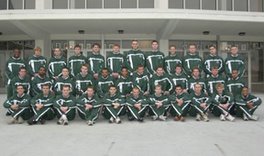Click here or read below.
Lawrence J. Joseph, esq.
2121 K Street, NW, Suite 800 - Washington, DC 20037
Tel: 202-669-5135 - Fax: 202-318-2254
www.larryjoseph.com
VIA FEDERAL EXPRESS AND EMAIL
April 17, 2007
John F. Burns, Esq.
Director of Legal Affairs
Pilcher House
Ohio University
Athens, Ohio 45701
Re: Title IX
Dear Mr. Burns:
On behalf of the Great Lakes Chapter of Equity in Athletics, Inc. (“EIA-GL”), this advises Ohio University (“OU”) that EIA-GL intends to file a federal lawsuit to challenge the U.S. Department of Education’s “Three-Part Test” under Title IX of the Education Amendments of 1972. We write now both to ask OU to postpone its plans to eliminate its swimming, track, and lacrosse teams and to put OU on notice of EIA-GL’s legal position.
By way of introduction, EIA-GL’s membership includes OU students, parents, and alumni associated with the teams that OU has scheduled to cut. Both EIA-GL and its members recognize that OU has acted to date under the misunderstanding that its proposed cuts comply with Title IX. As explained in the enclosed complaint in Equity in Athletics, Inc. v. U.S. Department of Education, No. 5:07-0028-GEC (W.D.Va.), however, Title IX neither requires nor allows such cuts. Quite the contrary, Title IX prohibits them.
Neither EIA-GL nor its OU members have any desire to sue OU. Our quarrel is with the federal standards and the federal regulators, who have misled OU and EIA-GL’s members alike. Significantly for OU’s attempt to comply with Title IX, EIA-GL will ask the court not only to vacate the Three-Part Test prospectively, but also to declare it void ab initio and to find that it never lawfully took effect. In essence, OU is steering itself to a mirage, not a safe harbor. Put another way, we are not trying to move OU’s goal post: that goal post does not exist.
Although OU undoubtedly believed that the Three-Part Test constitutes a current and valid interpretation of Title IX’s implementing regulations, it is not. We are confident that the Sixth Circuit will agree for several reasons, including the following:
Ø Prior Title IX Decisions Will Not Control. Although the Sixth Circuit already has ruled in favor of the Three-Part Test, Horner v. Kentucky High School Athletic Association, 206 F.3d 685, 694 (6th Cir. 2000), such prior decisions will not control here for four reasons: (a) they misconstrue the Department of Education’s authority, as made clear by supervening Supreme Court precedent; (b) they improperly defer to the Department, as made clear by supervening Supreme Court precedent; (c) they did not consider the administrative record and procedural requirements that would apply if the Department or its predecessor intended to adopt the Three-Part Test as a standard for Title IX compliance; and (d) the Fourteenth Amendment prohibits such quota-driven cuts, even if Title IX does not.
Ø The Department Lacks Authority to Issue Disparate-Impact Requirements. The relevant precedents that uphold the Three-Part Test rely explicitly or implicitly on the federal agencies’ authority to issue disparate-impact regulations under the intentional-discrimination statutes like Title IX and Title VI. In Alexander v. Sandoval, 532 U.S. 275, 281-82 (2001), however, a supervening decision of the Supreme Court ruled that agencies lacked such authority. Indeed, in April 2001, Sandoval rejected as dicta the very authority on which the federal government previously had relied as support for agencies’ authority for such regulations under Title IX. Compare id. with U.S. Dep’t of Justice, Title IX Legal Manual, 64 & n.48 (Jan. 11, 2001) (www.usdoj.gov/crt/cor/coord/ixlegal.pdf).
Ø The Three-Part Test Does Not Warrant Deference. The decisions that uphold the Three-Part Test rest on controlling “Chevron” deference to the Department of Education’s interpretation of Title IX. In United States v. Mead Corp., 533 U.S. 218, 227-28 (2001), however, a supervening decision of the Supreme Court re-established the lesser standard of “Skidmore” deference for regulatory regimes that (like Title IX) provide the same authority to more than one agency actor.
Ø The Three-Part Test Is Procedurally Invalid. As the enclosed complaint explains, the Three-Part Test (as subsequently reinterpreted by the Department in 1996 and 2003, purports to change a regulation that required equal opportunity, based on the genders’ relative interest, into equal participation based on enrollment. Even if such a standard was substantively lawful, that change would require notice-and-comment rulemaking. The Department’s predecessor recognized as much, and expressly did not take the steps required to implement such a change. Oblivious to the fine distinctions that its predecessor made in 1979, the Department’s 1996 and 2003 actions purport to create a legal requirement that the Department simply cannot create by memorandum.
Ø The Three-Part Test Is Not in Effect. Like its Title VI template, Title IX provides that agencies must act by rule, regulation, or order of general applicability, and provides that such actions do not take effect until approved by the President. 42 U.S.C. § 2000d-1; 20 U.S.C. §1682.[1] The legislative history makes clear that such approval meant signed by the President in the Federal Register.[2] 110 Cong. Rec. 2499-00 (1964) (Rep. Lindsay). As demonstrated by the partial list in the margin, Congress repeatedly cited the presidential-approval requirement as the bulwark against bureaucratic overreaching.[3] As the administrative record for the Three-Part Test demonstrates, the Department’s predecessor expressly did not seek to comply with any of the applicable procedures (including presidential approval) because the Three-Part Test was neither binding nor a test for Title IX compliance.
Ø Quotas Are Unconstitutional in Any Event. In its one departure from Title VI, Congress included Title VII’s restriction against preferential treatment based on imbalances with the total population, 20 U.S.C. §1681(b), which is “designed to prevent…. undue ‘Federal Government interference…. because of some Federal employee’s ideas of…. balance.’” United Steelworkers of Am. v. Weber, 443 U.S. 193, 206-07 (1979) (citations omitted). Although that provision allows courts and agencies to consider “statistical evidence” in a specific “hearing or proceeding,” 20 U.S.C. §1681(b), it “would be contrary to Congress’ clearly expressed intent” to allow “quotas and preferential treatment [to] become the only cost-effective means of avoiding expensive litigation.” Watson v. Fort Worth Bank & Trust, 487 U.S. 977, 993 (1988) (plurality); accord Wards Cove Packing Co., Inc. v. Atonio, 490 U.S. 642, 652-53 (1989). Thus, even if the Three-Part Test is a grammatical interpretation of the Title IX regulations, it is not a lawful one: “outright… balancing [] is patently unconstitutional.” Grutter v. Bollinger, 539 U.S. 306, 330 (2003); Truax v. Raich, 239 U.S. 33, 36-38 (1915) (“If [rights] could be refused solely upon the ground of [class membership], the prohibition of the denial to any person of the equal protection of the laws would be a barren form of words”). As a state school, moreover, OU must comply with the Equal Protection Clause even if the Department’s memoranda somehow authorize quotas under Title IX. Communities for Equity v. Michigan High School Athletic Association, 459 F.3d 676, 681-90 (6th Cir. 2006) (Title IX’s private action does not displace constitutional equal-protection action under 42 U.S.C. §1983).[4]
Finally, as you may know, the administrative record on the Three-Part Test surfaced in litigation against the Department initiated by the National Wrestling Coaches Association (“NWCA”), in which the Department prevailed. The government’s successful defense in NWCA hinged on standing, with the D.C. Circuit’s accepting the Department’s argument that NWCA did not establish redressability because NWCA did not establish that independent parties (i.e., schools), not before the court, would change their actions if NWCA prevailed. Cf. Bennett v Spear, 520 U.S. 154, 169 (1997) (“While… it does not suffice if the injury complained of is th[e] result [of] the independent action of some third party not before the court, that does not exclude injury produced by determinative or coercive effect upon the action of someone else”) (citations and quotations omitted, emphasis in original). The Department will not have that argument here: either the relevant schools will publicly defer their planned cuts, or they will not be independent parties not before the court.[5]
Even members of OU’s Board of Trustees privately have expressed the concern that OU did not handle these cuts well procedurally, and now EIA-GL has raised significant substantive questions as well. Significantly, plaintiffs can prevail against improper procedures, even if they ultimately would lose on their substantive claims. Carey v. Piphus, 435 U.S. 247, 266-67 (1978) (“right to procedural due process is ‘absolute’ [and] does not depend upon the merits of a claimant’s substantive assertions”). At the very least, therefore, OU should reconsider its cuts under the regulations’ equal-opportunity standard, as distinct from the Three-Part Test’s equal-participation quota.
Like many schools before it, OU has relied on the Three-Part Test. Unlike the schools that preceded it, however, OU would face a legal challenge from a plaintiff armed with the administrative record of the Three-Part Test. We hope that OU will recognize that this is simply not OU’s fight. Instead, for the sake of its students, we urge OU to postpone the cuts to allow EIA-GL time to establish what Title IX and the Equal Protection Clause require.
For a school ostensibly acting in part to save money and in part to comply with Title IX, going through with the planned cuts will not achieve either goal. First, given the out-of-state students (and tuition) that OU stands to lose, postponing the cuts may generate more money than it costs. Second, the cuts will involve OU in litigation, which it could avoid by postponing the cuts. Third, of course, if EIA-GL prevails, OU will face not only the costs associated with bringing the teams back, but also a significant award under the Civil Rights Attorney's Fees Awards Act of 1976. Fourth, and finally, although an EIA-GL member has filed an administrative complaint with the Department of Education’s Office of Civil Rights, he has authorized EIA-GL to indicate that he will withdraw his compliant if OU postpones the cuts. Even if postponing these cuts was not the right thing to do and the lawful thing to do, it would still be the most cost-effective thing to do.
Recognizing that we have presented you with a lot of information, we will do everything we can to assist you in understanding EIA-GL’s position. Ultimately, however, OU has the responsibility to comply with the law. As this short letter and the enclosed complaint demonstrate, OU should have serious questions whether the planned cuts indeed comply. The upcoming meeting of OU’s Board of Trustees presents an opportunity to revisit the cuts. If the Board does not act favorably, the time to resolve this matter outside of litigation will pass quickly. Notwithstanding the short time available, EIA-GL and its members will do everything in their power to work with OU.
Please do not hesitate to contact me – or to have anyone from your staff contact me – with any questions about this matter.
Very truly yours,
/signed/
Lawrence J. Joseph
Enclosure
cc: Dr. Roderick J. McDavis, President, Ohio University (via email w/o Encl.)
Dr. R. Gregory Browning, Chairman, Board of Trustees (via email w/o Encl.)
Board of Trustees (via U.S. Mail w/o Encl.)
[1] See, e.g., 118 Cong. Rec. 5803 (Title IX would have the same procedural protections afforded under Title VI) (Sen. Bayh). id. at 5808 (“These [procedural] provisions parallel Title VI of the 1964 Civil Rights Act”) (fact sheet submitted by Sen. Bayh); Sex Discrimination Regulations: Hearings Before the Subcomm. on Postsecondary Education of the House Comm. on Education and Labor, 94th Cong., at 170 (1975) (“the setting up of an identical administrative structure and the use of virtually identical statutory language substantiates the intent of the Congress that the interpretation of Title IX was to provide the same coverage as had been provided under Title VI”) (prepared statement of Sen. Bayh).
[2] In 1980, the President delegated the rule-approval and enforcement authority to the Attorney General. 45 Fed. Reg. 72,995 (1980) (Executive Order 12,250).
[3] See 110 Cong. Rec. 5256 (Sen. Humphrey); 110 Cong. Rec. 6544 (Sen. Humphrey); 110 Cong. Rec. 6562 (Sen. Kuchel); 110 Cong. Rec. 6749 (Sen. Moss); 110 Cong. Rec. 6988 (explanatory memorandum by Rep. McCulloch, inserted by Sen. Scott); 110 Cong. Rec. 7058 (Sen. Pastore); 110 Cong. Rec. 7066 (Sen. Kuchel); 110 Cong. Rec. 7067 (Sen. Kuchel); 110 Cong. Rec. 7103 (Sen. Javits); 110 Cong. Rec. 11,941 (letter from Attorney General Kennedy, inserted by Sen. Cooper); 110 Cong. Rec. 12,716 (Sen. Humphrey); 110 Cong. Rec. 13,334 (Sen. Pastore); 110 Cong. Rec. 13,377 (Sen. Allott).
[4] EIA-GL will not raise a merely collateral attack on the Three-Part Test. See Miami University Wrestling Club v. Miami University, 302 F.3d 608, 614 (6th Cir. 2002). Instead, by suing both the federal government and a relevant school or schools, EIA will directly attack the Three-Part Test. Cf. Smith v. Robinson, 468 U.S. 992, 1012 & n.15 (1984) (nothing prevents federal courts with jurisdiction over a controversy from reaching constitutional issues).
[5] In dicta, the D.C. Circuit also agreed with the Department’s argument that students lack a cause of action against the Department because they have an adequate remedy against schools. That argument will not work in the Sixth Circuit. Selden Apartments v. U.S. Dept. of Housing & Urban Dev., 785 F.2d 152, 157-58 (6th Cir. 1986) (“the review provisions of the [APA] are made applicable to agency action taken pursuant to civil rights laws by 42 U.S.C. §2000d-2”); accord Schlafly v. Volpe, 495 F.2d 273, 282 (7th Cir. 1974).
Wednesday, April 25, 2007
Subscribe to:
Post Comments (Atom)




















No comments:
Post a Comment